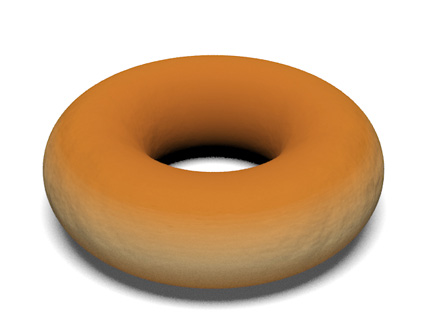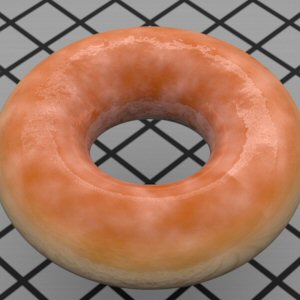We choose to render the most photorealistic donuts ever by using Matt Pharr and Greg Humphrey's
Photo Realistic Based Renderer (PBRT, see (http://www.pbrt.org/)).
Due to their nearly ideal shapes, and the availability of hot glazed donuts, we chose
to model the "doughnuts" of Krispy Kreme Doughnuts.
Although it was our intent to emulate actual advertising, this project was non-for-profit and
for educational purposes only.
Here we will discuss various developments in the project. Donuts are delicious cakes,
encapsulated in a flaky layer of dried honey glaze. To represent them correctly we need
to utilize various forms of techniques.
|
Using Direct Lighting Integrator. 2 samples. 31.4s.

|
Using Irradiance Cache Integrator. 64 samples. 275s.

|
|
Using Path Tracing Integrator. 2 samples. 193.1s.

|
Using Photon Mapping Integrator. 2 samples. 155.7s.

|
|
Using Whitted Integrator. 64 samples. 136.4s.

|
|
|
|
|
The "inner sphere" contained inside the glass.

|
Close up of the dough ball.

|
|
|
These images show some initial experimental results on what PBRT can already do.
The three items test three concepts. First on the left, we apply the "windy" texture
often used for waves as a bump map, to create a dough ball. Second in the middle, we
try to encapsulate a bump-mapped ball inside a smooth glass ball. This is not possible
with a direct lighting model so we have to use another kind of surface integrator. Third
on the right, we draw the killeroo in glass to demonstrate that enclosed triangle meshes
can indeed be made out of glass (because a volume that is not enclosed can not.
From an analysis of the integrators it seems that the path tracing or photon mapping
techniques are the most appropriate for drawing donuts. However if we could draw the
donut as one object (like the doughball), then draw the glaze as a transparent shell
(like the killeroo), then we might benifit greatly from using the Whitted integrator.
If possible we must try at all costs to use the direct lighting integrator for speed.
We found that good results are possible with direct lighting if the scene is set up
similar to photography studio lighting, which we will return to at the end of the project.
|
|
The next level of complexity was to create imperfections in our donuts procedurally.
This is contrary to the "hand perturbed" right-most donut shown above. Now, we intend
to break our torus model from a rigid body object to a soft body object. In a rigid body
the interrelations between all sub-objects (vertices, faces, etc.) must remain constant.
Meanwhile, in a soft body, each sub-object is considered it's own object, creating a
particle based system where each vertex is a particle. Putting these particle through
a dynamic motion field causes the whole object to become soft, like the dough we are
trying to simulate.
|
|
|
|
Ideal weighted donut vs. field perturbed donut.

|
Rendering of the field perturbed donut.

|
|
|
|
The figures above show an example. This donut has undergone a vortex field and a turbulence
field. The vortex field, which applies centrifical force of a spinning system to all particles,
is a good one for circular dough-made objects such as this. It is equivalent to putting the
uncooked donut ring on your finger and spinning it around like a hula hoop. Meanwhile, the
turbulence field emulates stresses caused by throwing the donut around. In this case, forces
from the two donut sides colide causing the donut to become more oblong in the perpendicular
direction.
|
|
It's not often easy to apply texture mapping to photo-realistic objects because the majority
of items in the real world don't require photographic texture mapping (textures scanned or
photographed). Even when texture mapping is applied it is usually procedural, such as a wood
grain, or a wrinkle in aluminum foil. Some items however, lend themselves nicely, such as a
poster on a store window or in this case, a donut box:
|
|
|
|
Realistic box modeling

|
|
Some empty boxes for our final scene.

|
|
|
The textures were scanned off an actual 6-donut Krispy Kreme box. However, there's a catch.
This box as shown does not exist in real life. Real 6 donut boxes from Krispy Kreme open
vertically and not horizontally. We swapped and extended the scanned box faces in Photoshop
to create this special edition box.
Further implementation details include the face choosing and hinging. Since we only use one
surface texture to draw each box face, we must take care to decide if we're looking at the
back of the face or the front. When looking at the back of the face, we must map it with a
blank white face. Meanwhile, for moving the hinge of the box, some amount of transformation
magic had to be done. The original box model is made as shown above at a 60 degree angle
opening. It was only after we decided to open it by different amounts, by using translations
and rotations in the appropriate order. This is overcomplicated by the fact that the box
origin is at the box center, and not on the box hinge.
|
|
The last and culminating step in our project is the implementation of BSSRDF.
This also indicates our choice of Krispy Kreme donuts for their hot glazed
donuts. Donuts look considerably different between when they are hot and after
they get cold.
|
|
|
1. Single Scattering
We followed the algorithm described in Jensen et al. [2001]. For a
given pair of (wi, wo), we computed the refracted direction of the
outgoing direction and randomly sampled along the refracted ray. With
the incoming direction wi, we were able find the intersection of the
incoming ray with the surface pi. About half way through our
project, we found a recently developed technique for single scattering
approximation by Wang et al. [2005]. The authors are inspired by
Jensen et al. [2002], which decouples the sampling and computation of
illumination in diffuse scattering. The paper presents a similar
approach for single scattering. Instead of sampling along the
refracted ray, the algorithm samples along the normal vector of the
outgoing ray to make precomputation feasible. The paper proves that
the approximation achieves high performance and yet generates high
quality images. If we had more time, we would be very interested in
implementing this algorithm and comparing it with the traditional
computation.
|
|
|
2. Diffuse Scattering
Our implementation was based on Jen et al. [2002]. We uniformly sampled
the torus in the theta and phi dimensions to compute the irradiance
at the sampling positions. We implemented both direct lighting and
photon mapping to calculate the irradiance. Our final images are
rendered with the direct lighting surface integrator. The image below
shows a distribution of the sampling points around the torus surface
(generated by an OpenGL program). During the integration steps, originally we
stored the samples in a 2D array and only integrated samples around
the intersected point, since the contribution of samples follows an
exponential fall-off. This worked fine with simple environments, but
failed when the lighting setup became complicated and the integration
missed important points; where the illumination is high. So instead,
we stored the irradiance samples in an octree, which kept track of
the clustered values of all samples in the tree nodes. The integrator
summed up the values (weighted by diffuse reflectance) in the tree
nodes. An error function was used to decide when to stop traversing
down the tree. We didn't get a chance to implement the sampling on a
trianglemesh, which would give us more flexibility to render other
translucent objects such as the milk.
Subsurface Scattering allows us to scatter diffuse and specular
reflection around the torus surface, giving the glazing effect. The
following image shows the light scattering on a vertical torus.
|
|
|
|
Sampling

|
Scatter of the BSSRDF

|
|
|
3. Glaze material
We tried various combinations of different reflection models with
different coefficient values to obtain the correct light interaction
on sugar glaze. We tried modeling the glaze as a separate layer from
the dough (i.e. one torus inside of the other), but the outer layer
doesn't allow enough light to go through and the bump mapping in the
inner layer is completely blocked. Our final glaze material contains:
- diffuse reflection, microfacet reflection (it attaches shininess)
- fresnelblend (it enhances the blending across multiple layers)
- specular reflection (with a relatively low portion, it makes the
surface smooth, without completely covering the bump mapping)
Which gives us this result:
|
|
Before Glaze

|
After!

|
|
Finally we are poised to create a full order of donuts for all tastes.
For this, we also created a model of Krispy Kreme's jelly donut.
|
|
|
|
Donut 0: Hot Glazed

|
|
Donut 1: Cold Glazed

|
Donut 2: Chocolate Iced Glazed

|
|
Donut 3: Vanilla Iced Glazed

|
Donut 4: Strawberry Iced Glazed

|
|
Donut 5: Maple Iced Glazed

|
Donut 6: Sugar

|
|
Donut 7: Chocolate Iced Creme Filled

|
Donut 8: Chocolate Iced Custard Filled

|
|
Donut 9: Glazed Lemon Filled

|
Donut 10: Glazed Rasberry Filled

|
|
Donut 11: Powdered Blueberry Filled

|
Donut 12: Dulce de Leche

|
|
|
Jelly donuts were modeled by deforming a sphere into a disk in Maya, adding "weight"
to the dough by shifting certain vertices, and then calling the same turbulence
field techniques from before on the model. Creme for all donuts was created by raising
the upper half of a top shell for each donut. Finally, the actual jelly squirt
coming out of the side of the jelly donuts was created using the boolean
difference techniques of Maya, and then doing a lot of vertex shifts to
model the squirt dome just right.
Also important are the texture mapping on the sugar, powdered blueberry, and dulce
de leche donuts. The sugar texture is mixed similar to the cold glazed clouds, but this
pattern is a simple noise field taken through various high pass and contrast filters.
The ideal reflection is actually mapped to the exact sugar pixels by reusing the same
texture map as a floating monochome map. This causes only the sugar particles to be
reflective. The jelly donuts use similar techniques but in
this case, their textures were pre-distorted to smooth out the polar distortions caused
by classic spherical mapping. This helps to evenly distribute the cloudy and non-cloudy
regions, but it can not avoid the natural polar distortion which happens.
|






































